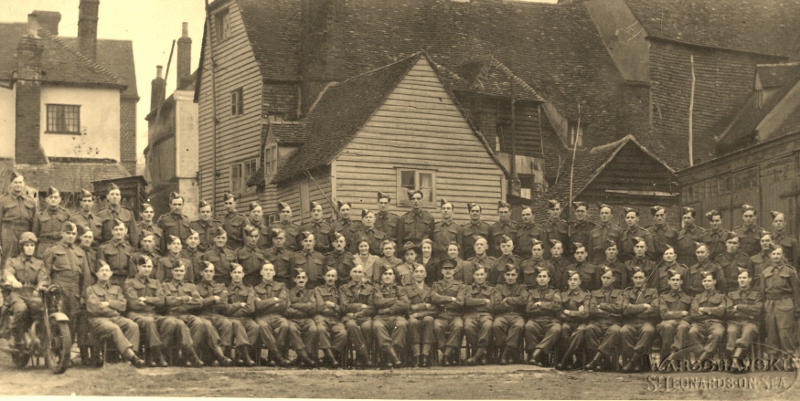Robertsbridge Memories
Changes 1983 to 2020 - David Allen 70 years of Life in the Village - Dorothy Martin Shops & Businesses 1930s to 1980s - Helen Waghorn Penny a Leg - Francis Fisher History of Salehurst School - Margaret Gregory Childhood Memories - Ethel Morfey For King (or Queen!) and Country - Jean Woodgate John Stenning & Son - David Allen Robertsbridge at War! - Len Woodgate Memories of an evacuee - Derek Stubley Memories of another evacuee - Roy Pickett Darvell Hall, Past & Present - Harry Bashford Early Flying - Len Woodgate Ghosts - David Allen Robertsbridge Home Guard 1944 - Len Woodgate Doodlebugs Parish News 1965 Diary of Ethel Mercy Burchett - 1906 Family album of Burchett-Butcher Holidays in Robertsbridge 1949 to 58 - Brian Thompson Down Your Way - David Allen
In this section you will find reminiscences of local residents. I intend to expand the section as more memories become available. Some are in .pdf format and you will need Adobe Acrobat Reader to view these documents but this can be downloaded free of charge from Adobe. I am very grateful to all who have allowed me to make these reminiscences available.
Many of the memories recall shops and businesses in the village and below is a selection of advertisements that have appeared in the parish magazine 'The Villager' over the years. Note that in 1938 in Robertsbridge two digits were sufficient for your phone number!
I am grateful to Mrs. Jean Woodgate for allowing me to reproduce her copies of these.
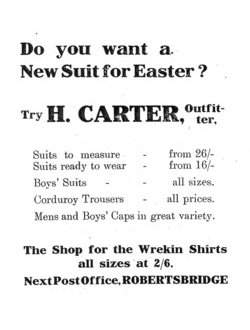
1909 advert
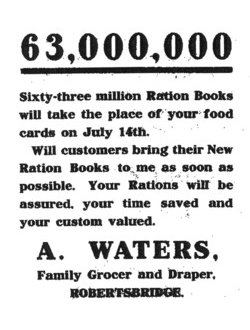
1914 advert
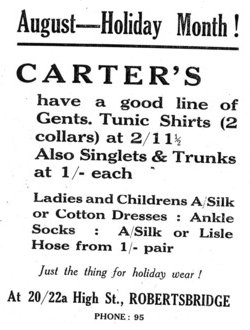
1938 advert
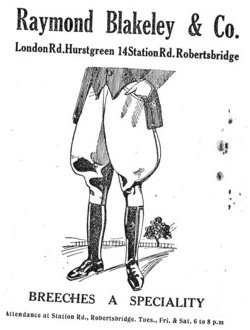
1938 advert
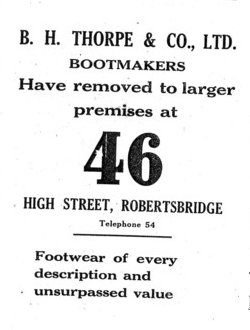
1938 advert
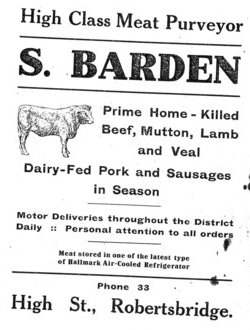
1938 advert
For younger visitors who may be confused by some of the prices quoted in the advertisements and reminiscences it is perhaps worth pointing out that until decimalization in 1971, the United Kingdom had a system of currency based on pounds, shillings and pence: 1 pound = 20 shillings and 1 shilling = 12 pennies (240 pennies in the pound); with decimalization the Pound was divided into 100 New Pence and therefore 1 old shilling became worth 5 New pence and 1 New pence was worth 2.4 old pennies.
As an example of comparative values, in 1914 £1 was equivalent in value to approx. £98 in 2019 and 6 old pennies (2.5p) was equivalent to nearly £2.50. In 1939, the comparative values were approx £45 and approx. £1.10p.
You can check other values at the very useful site Measuring Worth
Changes 1983 to 2020 - David Allen
I moved to Robertsbridge with my wife and family in 1983, having lived for several years before that in Etchingham a village a few miles away. During those years we have seen many changes and here we have listed them and included photos where available.
Brightling Road to level crossing
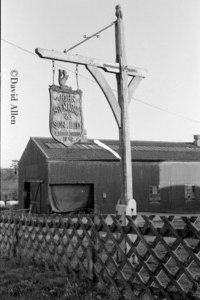
John Stenning & Son were a major employer in Robertsbridge for over 100 years until their closure in 1986. The land was subsequently developed for housing - Mill Rise - with the exception of approx. 10 acres of land which lay to the south of Bishop's Lane and had been used by Stenning's for storing wood supplies. This area was given Rother District Council as 'planning gain' and with strict covenants attached so that it became used as Public Open Space and was renamed, Bishop's Meadow.
A small part of the land had been occupied by someone who was running a small wood yard but without any lease and the developers wanted them removed. However, Rother DC negotiated a compromise whereby the occupier could continue his business with a non-renewable lease for 15 years at which point they were to remove from the site which would then be incorporated into Bishop's Meadow.
In 1995, Rother DC agreed to the Parish Council taking over management of the Meadow and a 99 year lease was granted but, a condition of the lease was that under no circumstances was the lease on the woodyard to be extended and at the end of it the PC was to take over the site and incorporate it into the Meadow - this was subsequently done.












These photographs were taken in Dec 1986 when the yard had closed for business and the machinery was being organised for sale.
Some memories of the Stenning's works by a Robertsbridge resident and long term employee, Mr Len Woodgate, can be viewed here.


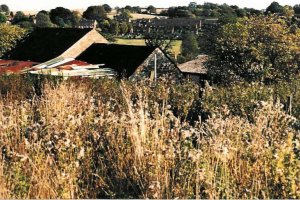
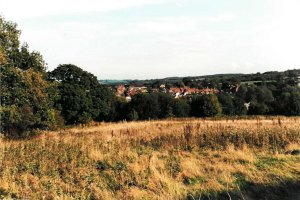
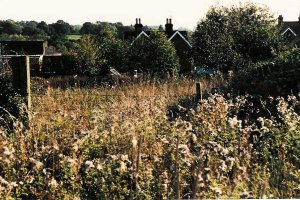
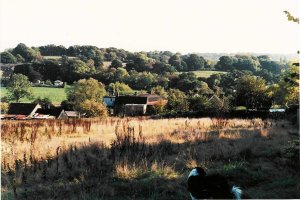
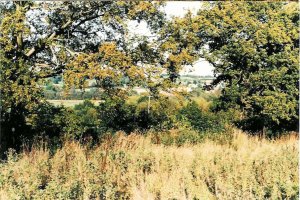
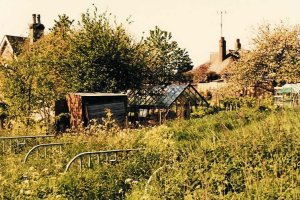
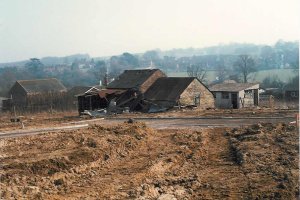
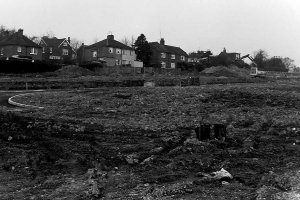
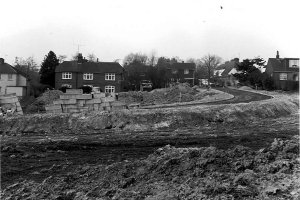
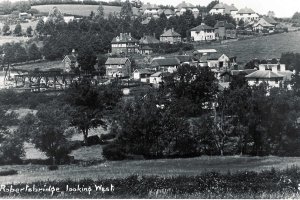
Behind Bellhurst Road, there were open fields until Glenleigh Walk was built in 1988.
Next to the railway level crossing, on the north side, was the Bungalow Stores a home and small grocers shop which closed in 1985 - the area was re-developed for two houses, 'Southwold' and 'The Mumbles'.
Station Road from level crossing to High Street
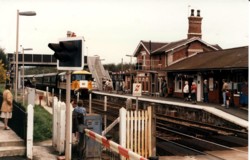
After years of uncertainty a decision was made to electrify the line to Hastings and on 6th May 1986 the Royal train carrying HM the Queen Mother passed through Robertsbridge en route to Hastings for the official opening. Opposite the station on the south side was the John’s Cross Coachworks and workshops, now occupied by four small houses and a small factory – Aviamax.
The Ostrich pub is still open. Further down, Culverwell's only sold agricultural equipment and supplies before branching out into car sales.
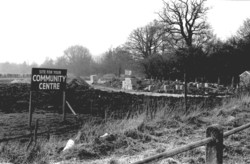
The village hall was not built until 1988. On the south side from the hall to Willow Bank the flood defence bund and gates can be seen. The Oldwood surgery was in 1983 located in the High Street. Gray-Nicolls now occupies the wooden clad building next door which was previously the Garden Machine Centre, the latter has moved to the station yard.
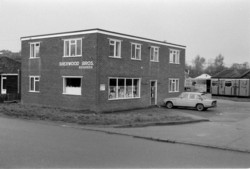
Willow Bank was not built until 1990. Opposite, the brick building now housing Gray-Nicolls offices and store rooms was Sherwoods Builders merchants. Across the Darwell stream, on the right the newsagents owned by the Woodgates in 1983 was flourishing but closed some years later but re-opened in 2008 as a Village Stores and Post Office.

Next door, Common's cycle shop was replaced by Classic Motorcycles, which for a while was based opposite in Western House, which in 1983 was a small hardware store but is now residential. In 2007, Classic Motor -cycles was replaced by Classic American Motorcycles, specializing in Indian brand cycles. This subsequently closed and now house Moat Osteopath practice.
To the side of Western House the drive leads to Bakery Close which in 1983 was the site of the bakehouse for Douch’s bakery in the High Street.
At the junction with the High Street on the south-west corner, the veterinary surgery was a branch of Barclays Bank.
High Street - west side southwards
No. 61 H1gh Street was A. Gore & Co, Property Agents and now a private house. After several changes The George pub has been open for a few years as a very good restaurantand pub. The former southern car park of the George and its gardens have been developed for housing (2007) and beyond that, the former Country Crafts site where fencing and other wooden goods were made has been closed for some years and has been developed for housing. Further up George Hill, is Burton Cottages a residential home for autistic adults and was a small wooded area.
High Street - east side northwards to the Clappers
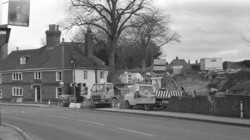
On the east side of the road the new primary school opened in 1988 having been moved from its Victorian building in Northbridge Street to make way for the bypass. The Children’s Centre was built in 2007.
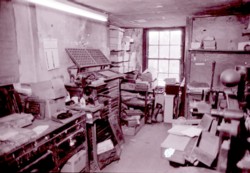
Saddlery Antiques occupied what is now the bookshop and next door, Mr Brett's print shop is now residential accommodation, Print Cottage.
The lovely 17th C. hall-house, the Seven Stars pub, has had a chequered career and is currently closed.
Fair Lane in 1983 was a through road to Park Farm and the Abbey but was closed to through traffic when the bypass was built - there is now a footbridge over the bypass. Past Fair Lane, what is now Floral Art was at some time an interior decorators and next door to that a second hand designer women's clothes shop now closed.
Then came the hairdressers, since closed, then the post office which transferred across the road and also opened as a travel agents. The Post Office has now transferrred to the Village Stores in Station Road and the premise have become a beauty salon.
Next to the post office was Gwen Taylors haberdashery shop, now Floral Boutique. Beyond that, Robertsbridge Garage occupied the site that is now Abbey Mews
High Street - west side, Station Road to the Clappers
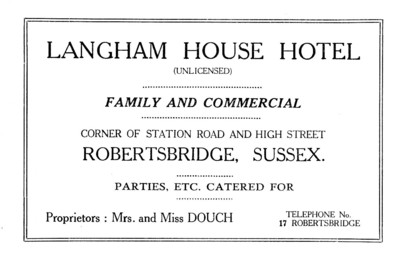
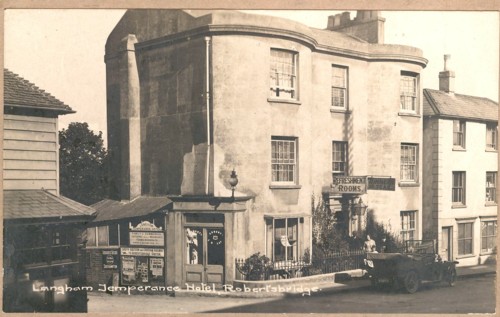
On the corner of Station Road is Langham House which was formerly the Temperance Hotel. It then housed the village butchers but is now Judge's Bakery and coffee shop.
De Montford Antiques occupied No. 49, then Beeden's shoe shop and repairers (No.47), then the Bough House, a very good restaurant (No.43) and next to this, Douch's bakery, now Scissors hairdressers. Then Croucher & Fullers's grocery store, now One Stop.
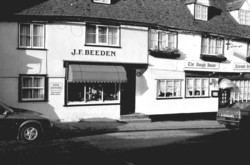
Further down the pharmacy was in No. 37 and then, after the twitten leading to Hoadley Terrace, R.N. French selling domestic electrical goods, occupied what is now a small residential flat and the current pharmacy.
What is now the beauty salon was Mrs Madge's flower shop, which has crossed the road and become Floral Boutique run by her daughter. The Indian restaurant was the Blacksmith's restaurant followed for a very short time by a Noveau Cuisine restaurant, the Trompe l'Oiel. To the rear of the restaurant, the car park has now largely been built over with Pelham Place.
Across the Clappers to Northbridge Street
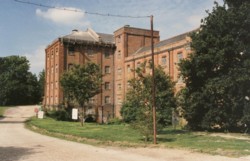
Two sets of flood gates can be seen either side of the river and in the playing fields between them the new football and cricket pavilions which have replaced the rather dilapidated pavilion which was there in 1983.
SCATS mill for a while was owned by Grampian Foods but then closed with further loss of employment and is now (2007) being considered for re-development as housing and commercial premises.
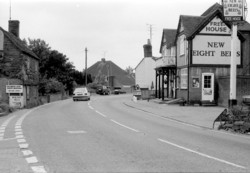
At the northern end of Northbridge Street, the old A21 is now a cul-de-sac and a new road branches of to the bypass just beyond Rutley Close. The New Eight Bells pub has now closed and is converted to residential and the site of the garage which stood opposite is now occupied by housing.
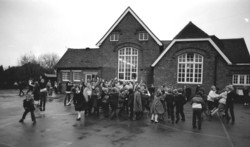
The old primary school building survives as residential accommodation but has lost most of its land to the bypass.
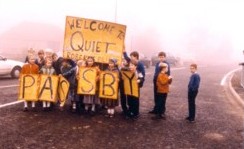
The opening of the bypass on November 13th 1989 was much welcomed in the village and it is difficult to see how the village could have coped with the increase in traffic over the last 20 years without it.
An amateur video of the by-pass opening was made for Bill Shelley. For more information contact Simon Oakley
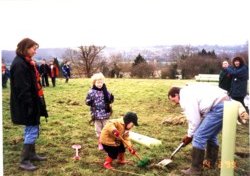
Across the bypass into Salehurst, little has changed in the last 25 years. Behind Coronation Cottages, a new wood was created, Springfield Wood, to mark the new Millennium and many villagers turned out on 14th February 1999 to help plant the trees.
70 years of Life in the Village - Dorothy Martin
In 1988 Dorothy Martin MBE who lived most of her life in the village produced her recollections of village life over the previous 70 years. 10 years later she added further thoughts and updates and she kindly allowed me to reproduce these here. Sadly, Dorothy died in 2007.
Shops & Businesses 1930s to 1980s - Helen Waghorn
In 2005, Helen Waghorn (b. 1911) put together her memories of the shops that had been in Robertsbridge between the 1930s and 1980s. Helen died in 2004 but her cousin, Ruth Waghorn, has kindly given me permission to use her document.
Penny a Leg - Francis Fisher
This is the reminiscences of Mrs Francis Fisher, who lived the whole of her life in Robertsbridge. She attended Salehurst Primary school starting there in 1899 and later taught there for many years. I believe it was written in the late 1970s.
History of Salehurst School - Margaret Gregory
In 1992, Margaret Gregory, a Robertsbridge resident wrote a history of the Salehurst Primary School - Our Village School Past and Present. This was some 4 years after the school had moved into a new building to make way for the bypass. Margaret moved from the village some years ago but has kindly given me permission to make this available here.
Childhood Memories - Ethel Morfey
In February 2008, I was contacted by Ian Morfey who had some reminiscences that his mother, Ethel Morfey, had written in 1976 when she was 69. Ethel was born in Salehurst in 1907 and her reminiscences were mainly for the years before the 1st World War in 1914. Ethel's mother's maiden name was Bishop and was one of 14 children all born in the parish.
Ian was one of 4 children and was born at Bodiam but attended school at what was then Robertsbridge Secondary School from 1956-60. Ian wrote:
"I first became aware of this book in October, 2006. My sister June passed it on to me when we were chatting about family history. I retain the original hand written exercise book that mum used for her memories and typed them up so family members could have copy if they wished."
He has now very kindly allowed me to reproduce this delightful reminiscence of life in Salehurst nearly 100 years ago.
It can be read below or in this PDF.
These are the memories of ETHEL MARGARET MORFEY, nee DANIELS.
- Born 7th June, 1907, at Abbey Farm , Salehurst, East Sussex.
- Died 19th July, 1986, Aged 79 years.
- Wife to Frederick (Fred) Morfey.
- Born 27th November,1904 at Rye Foreign, East Sussex. Died 3rd December, 1976 Aged 72 years.
My daughter ( June ) wants me to try and write down some of the things I used to tell them about my childhood days in the country.
I am 69 ( therefore written in 1976 ), but I can truthfully say I remember back to four years old.
My father was a Carter on the farm and we had a farm cottage near the farm.
The farmer had a little boy about the same age as me, perhaps a little older. We played all day together. There was a big orchard with a pond in it. I remember one thing I had to do was when the apples were falling. It was to walk round behind him holding out my pinny ( pinafore ) as we called it, for him to fill with apples to throw at the ducks.
But the one really naughty thing we did, was to pour a big can of paraffin oil down into the well of drinking water. It caused a lot of trouble. My father, with one of the horses had to go a long way down the lane to the nearest cottage every day. He took a big thing called a bodge, the horse had to pull it along. They had to fill it with clean water for several weeks until the other one had cleared.
I started school from that farm and had to walk three miles. Then my father moved, not far away, but about another mile added to the walking. There was no such thing as school dinners, you just had the cold food you took with you. If it was very cold in the winter we were allowed to eat our dinner in the passage where we hung our coats. I think I shall always remember the awful smell of the wet clothes in the winter.
We had to go even when it was snowing, which it did in those days. We had no wellies (Wellington boots-ed.), just pulled some old black stockings over our boots. Button boots for a girl of course.
The summer used to make up for it, I shall always remember the wayside flowers. My children laugh at me because I love Bumble Bees and all the Butterflies which we don’t see now.
I was nearly seven by now and used to go with my father a lot, that’s when I began to be interested in the big cart horses.
I must remember to tell you this farm was also a big dairy farm and the owner was a very big name, so I won’t say it.
I remember the backache, because all of the children on the estate had to pick up acorns for the pigs. Big sackfulls for a penny.
We did have a party given to the workers at Christmas. I remember having to bow and say thank you for a red flannel petticoat. Our mothers had a grey one and the men a woollen waistcoat.
It was now the summer of 1914. I had forgotten to say I was the very youngest of our family. I remember my older brother Frank coming home after nine years in the navy and saying to my mother, " Look at that , a brand new kit bag. I’ll be called back in a couple of months". He was, to the 1914 war. He was taken prisoner at the Battle of Jutland (1916 ed.).
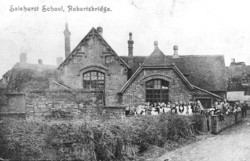
Salehurst school c. 1910
Now once more we move , but only two miles. But better for me for school, just time to run home the half mile to dinner. This was to a little place called Salehurst near Robertsbridge.
I was born down at the old Abbey Farm which of course has its history. My father told me that his granddad claimed to be one of the last people to see a man and his dog go into a tunnel that was supposed to go from Robertsbridge to Battle Abbey, then it collapsed and was sealed up.
But to go back to memories of the 1914 war, they never touched me. We were never short of food, as this farmer Mr Tom Hoad was a good man to work for. I remember going to get the eggs at the Farmhouse door, one shilling a dozen. The sister who kept house for him used to give me two lovely brown ones , for myself she would say. They also sold farm butter and of course there were plenty of rabbits.
My mother used to make a big cake and sew it all up in what I think was Butter Muslin, pack it in a tin and post it to my brother who was a prisoner. He told us when he did come home they were not treated too badly, he was a Chief Petty Officer which helped in those days. The one thing he longed for was soap. They knew the guards were hungry and made a bargain, a piece of soap for a piece of cake.
My other brother Jim (Baptised - Frederick James ) was in the 50th Royal Sussex Regiment. He went in when he was 17, by putting a year on. I remember him coming home on leave.
But I didn’t realise why he had to go out into what we called the old bakehouse, I was just pleased to see him. My poor mother had told me since it was to bath in the old tin bath and burn all his underclothes . I feel sad now when I think of her dreading him going back. But thank God he did come back, but I think never the same person.
During all this long time I was leading a very happy childhood. My father was very happy on the farm. I think his wage was thirty five shillings, five more for being a Carter.
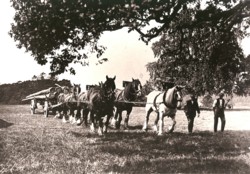
Working horses were a common sight in Ethel's childhood
He had two lovely horses to work with Diamond and Blossom. I have a lovely photo of him when he had been ploughing with them. It was a huge field and every furrow was as straight as a die. I still look at it now and can’t see where it looks any better than it did. The tractor is time saving but surely it can't give you the satisfaction.
One little incident that I was told by my mother was the day I was missing when I was three years old, but my father had an idea where to look. He told my mother how he felt when he stood in the stable door and saw me under one of the huge carthorses trying to tie my hair ribbon round its big leg. He said that he said quietly 'stand' to the horse and called me out. They were so gentle.
But back to my own memories. I used to go up the stable every day with my father to Rack Up as he called it. Some old Sussex name I expect, as my father was very Sussex. I wouldn’t know how to spell some of his words.
Anyway, it was to feed and bed down Diamond and Blossom while he was putting their clean straw down. He used to let me get their food ready.
In the little room just through the door was a huge bin with different places in it. As I remember one was for corn, one for the (evots ? ), otherwise oats. One had a kind of bean in it, I think they were called Locas Beans- they were black looking and tasted quite nice. And then there were great slabs of cake to break up.
I can see it all now so plainly with the old stable lantern hanging on the wall for light. He used to give them some medicine called Salt Peter. They evidently didn’t like it much as I used to hear a lot of ‘ come along Blossom old girl’ and ‘give over Diamond ’. They knew my fathers cough, as we came up the road they would answer him.
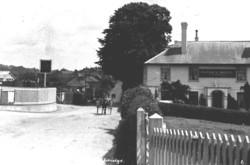
The milk cart at Robertsbridge station
As well as those there was Mary, she was a lighter horse . She was for taking the milk to Robertsbridge Station every night, for the London train. I knew her and loved her, but didn’t have so much to do with her as my fathers helper called a Carters Boy did the harnessing of Mary to the milk cart every night, about five I think.
If we wanted to get a lift up to the doctors at Robertsbridge we had one with Mary and the Milk Churns in the back. My brother-in-law was one of the milkmen, as my sister was fifteen years older than me. I loved to watch the old doctor making up the medicine, a little of this and a little of that, a look along the shelf and another little drop of something. Much more exciting than our boxes of pills. He cycled about four miles from Hurst Green to Robertsbridge until he was eighty.
In the summer on a Sunday, twice a year the farmer would let us have Mary and the trap. We went about twenty to thirty miles to Headcorn in Kent to see my father’s brother. We enjoyed the ride and so did Mary as she didn’t have enough to do. I am afraid my father got a bit sleepy, as my uncle made his own cider. My mother never worried, she said Mary would take us home. Of course there was not much traffic then.
Thinking of traffic makes me think of how terrified I was of the Steam Roller when I first started school. Living on the farm and not going out to the main road much, I had never seen one. Two bigger girls had to drag me by it , the children now would think I was mad. I wasn’t frightened of the Threshing Machine which came after each harvest to thresh the corn.
I had a little black and white terrier called Spot. My father took him up to the farm when they were getting to the bottom of the stack, as he was such a good ratter. I heard my father say he had twenty five a day.
I also had a big black tomcat I called Dick, he used to bring rabbits home to my mother. He used to wait while she got it skinned and cut up for us, all he wanted was his pieces. Today’s cats are to well fed to bother. I never saw such a thing as cat food yet he was so heavy I had a job to have him on my lap, which he liked. He used to let me put a dolls bonnet on him and would clown in front of the fire with me and the dolls and Spot.
I wouldn’t have had time for television.
I had a cripple brother also ( George – believed a polio victim ) who of course in those days nothing was done for, except by the rector. The Reverend Ward I think was vicar for fifty years, he used to go and try to get him to make little rugs, he would also read to him. So nights I used to tell him what I had done at school . We had a big scrapbook which I used to paste pretty cards in.
Then sometimes in the winter we would sit round the fire and my father used to sing old songs to us. One I am sure must have been an old Sussex folk song. I have never heard it anywhere at all since. It was about a servant girl that got herself in trouble and was turned out. I always remember the lines where she put her box upon her head and ‘ganged’ it along, well that’s what it sounded like. Others were Wrap me up in my old Stable Jacket, Dick the Carters Lad and I’ll take you home Kathleen.
At Christmas we had a lot of friends and relatives in. Two of the farmers nephews used to play the Hand Bells, I haven’t heard them played for a long time. They used to play the Bells of St.Mary’s. My mother lit the fire in the old bakehouse. If you have never seen one, it’s a big brick place and you got it ever so hot and then raked out the ashes. She made Christmas cakes and something called fleed cakes which we all liked a lot. She even made my wedding cake in it in 1925, probably the last time it was used as we moved away soon after.
The one thing I really miss today is the way families kept together. My mother was one of seventeen children. I think there was only about four died as babies, so you can guess at the amount of Aunts and Uncles we had. My cripple brother and I used to amuse ourselves, but we visited them and they visited us. We used to walk about six miles to Ticehurst and back the same day. I remember my mother kept saying 'Are you tired' and I said 'No, only my legs ache'.
I remember my uncles big old pantry with all his wine in, not like the stuff they make now. He had Elderberry, years old, when you held it up it was a lovely clear ruby colour. He also had Dandelion and Parsnip, looking like whisky. I had some lovely times there. He used to play his concertina and the whistle beautifully. They had one of the old round cylinder type gramophones or should I say phonograph. One old tune was called The Vacant Chair.
I am sorry this is so muddled but memories crowd in so fast I don’t know what to put down.
My mind has just gone to the horses again. One of their other jobs was to come out to the Hop Garden and get the bags of hops, as we picked in the bins in the hop garden then.
The farmer used to come round and call " Hops ready ". We cleaned out the bigger leaves that had fallen in the bin and he measured them out with a Bushel Basket. I think we had two pence a bushel then in 1915. But he was very good , if at the end of measuring it was only half he called a bushel. I had to stay by the bin and pick six boxes in the morning and in the afternoon, then I could go and play.
After all my new winter clothes had to come from that money. I had to take last years best coat and hat for school and have a new Sunday hat which we did in those days. I am glad I have never had any photographs of myself in my Black Beaver hat with red cherries round the side. I loved it, but my children would have laughed their heads off I expect.
We had to have a trip to Hastings for the new clothes, I expect the whole outfit was only about three pounds. I remember the first coat I bought myself when I was fifteen years old, it was only thirty shillings, a lovely thick one.
There wasn’t a Woolworths in Hastings then. Only a tiny little Marks and Spencers, and that wasn’t for clothes, just two long counters with odds and ends and little ornaments and Hastings Rock.
I have strayed from the horses again, they took the hops to the Oasthouse, where my father dried them. He had to leave everything else for that. We didn’t see him much as he had to have what sleep he had , on an old bed made of posts and wood across and straw filled bags on. But it was lovely and warm there as they dried with fires under the kilns in those days. He had a mate, so one watched the fires while the other had a nap.
My mother used to wash some big potatoes and say " take these up to your father to bake in the fires " , they were lovely with lots of butter on.
There wasn’t much my father couldn’t do, he used to thatch all the haystacks. But I must say I never saw him near the cowsheds , each man to his own job in those days I expect.
I used to have to go up every night for our milk, we had three pints of milk. If I was there early I used to watch them milking, by hand of course then. They took it across to the dairy and poured it through the cooler, some of it went through the separator to get the cream to make the butter. I used to like to see the butter making, all the patting with the two little wooden butter pots (?pats Ed.). Then the final glory to me was the pattern of the thistle and leaves on the top of the half pound pots (?pats Ed.).
I said we had a very nice rector. We had a lot of people at the church in those days. I was in the choir until I was fifteen and loved it. Church three times on a Sunday, eleven o’clock, three o’clock children service in the afternoon and six at night.
We lived close to the River Rother and used to go paddling in it, it wasn’t so deep as now as it didn’t used to be dug out like it is now. The flowers along the banks were lovely. We used to go for long walks along its banks right through from Salehurst to Bodiam and get big bunches of flowers to take to school.
I am sure I am right when I say the evenings in the summer when I was child were much longer and of course much hotter. We played outside because it was too hot to go to bed.
I slept in our big attic, so it was hot under the roof. It had a part that was curtained off, where my father stored all his potatoes and carrots which he had grown to last the winter. They were in big wooden tubs covered over with straw. But I loved my attic bedroom, my mother kept all her oddments of material from sewing up there too. I used to look among them for pieces to make dolls clothes, as we played with dolls a lot in those days.
My older sisters spoiled me. I think ( Louise ) the one that worked in Hastings for a German Countess married to an English Gentleman, bought me a lovely dolls pram. When we went to see her ( Louise ) I had to go in to the drawing room to see the Countess, she was very kind to her maids. She always gave my mother a big jar of cod liver oil for me, as she said I was growing too fast. Lucky for me my father liked it, because I hated it. She had a lot of Doves in an aviary and several dogs, my sister had to look after them. When my sister got married the Countess sent her two telegrams, one from the doves and one from the doggies. I suppose she would be called eccentric nowadays.
I just can’t understand all this deepfreeze mania now, we had some lovely food. The butcher came three miles on a bicycle with the big basket on the front and we never had bad meat. I only wish I could get some of those lovely home made pork sausages now that were about one and sixpence a pound.
Of course everything wasn’t perfect. I was just thinking of sharing the old lavatory outdoors with the neighbours and having to wait ages while the son was sitting there reading. My mother kept complaining until the farmer had another wooden one put up, and of course in the winter I was afraid of going down there in the dark.
My sister was married during the war and lived with us as her husband was in the navy. I remember she was expecting her first baby and I wasn’t supposed to know anything about it. I had to pretend such great surprise when I got home from school to be told I was an auntie at eleven years old. Yet last week I heard my granddaughter of the same age asking her mother what the hospital had said about the check up, progress I suppose.
We are now near the end of the war, when we heard it was over we were excited at the thought of seeing my brother. One morning going to school this big man passed us and asked us where Mrs. Daniels lived, that was my mother. I had not seen him since I was seven, but I said to the others " I think its my brother ", I turned and raced home ,I said " Mum Frank is coming up the road ".
She said " It doesn’t matter about school, go and find your father ". He was ploughing in the big field I have talked about, but he tied the horses up and came home to see my brother who had a lot to tell us.
I think times were hard for a lot of people then, but my brother went to work on the farm and also my brother in law.
I left school when I was thirteen years old and went into service. I am afraid it didn’t go down very well after the easy time I had been having. I met my husband when I was sixteen and we were married in 1925 when I was eighteen and a half years old and we had our Golden Wedding last year.
I have a lot of memories, some of them hard times. My husband was out of work for the only time in his life in 1927. I remember we were in two rooms in Hastings, seven and sixpence a week. We had twenty six shillings dole money, all I can remember is living on beef sausages at eight pence a pound. Then my mother wrote and told us that a Captain Townsend of Bodiam Manor wanted a second gardener. It was for thirty shillings a week and a old cottage, which we took because we had no choice. My husband worked there for four years, but he had to go indoors and cook as they couldn’t keep anyone.
So we looked for another job and got a big lift up as Chauffer/Gardener at a big house at Sedlescombe for two pound a week and a much nicer house. My husband had to learn how to drive the big new green Humber car and he had a dark green uniform and a peaked cap. He had to take the daughters to the Hunt Balls. His one dread was the boss taking the wheel , as he was eighty years old . My husband used to sit with his feet pressed to the ground with fright because the old man drove so fast and he was shaky.
My first memory of cars go back to 1912. The big ( important )gentleman Mr Luxford that my father worked for bought two cars and done away with the horses. They were a Daimler and a Rolls Royce, the poor coachman had to learn to drive. We children used to run along the road to see them come down the drive, but we were really scared of them. Great big headlamps gleaming, Mr Luxford was a small man with a little white beard. He used to sit up so straight on the back seat staring straight ahead.
For King (or Queen!) and Country - Jean Woodgate
Mrs Jean Woodgate has researched residents of Robertsbridge and Salehurst who joined the Royal Sussex Regiment (1904-1909) and the 1st Cinque Ports Rifle Volunteer Corps (1859-1904) and has kindly allowed me to reproduce them here.
It appears however that not all were so patriotic and she also found the following notice:
Lawrence Hy - from H.M.S. Charybdis on 22-05-1868
O.S. age ? 5 feet 6 inches tall brown hair, sallow complexion
Former ships - none. Born Robertsbridge - Straggler (deserter Ed.)
27-05-1868 - A reward of £1 is offered for the apprehension of this man
Six ships of the Royal Navy have been named H.M.S. Charybdis after the sea monster of Greek mythology. This must have been from the third.
Robertsbridge at War! - Len Woodgate
This story was sent to me by Robertsbridge resident, Len Woodgate. It makes an amusing story now but must have been pretty alarming at the time. However, it also reminds us of the many Canadian troops, and other nationalities, who were based in and around our village in preparation for the subsequent invasion of Europe in 1944.
Many, of course, subsequently lost their lives in those battles and we owe them a great deal – Ed.
During World War 2 many Canadian Army troops were stationed locally and were occasionally involved with the local Home Guard in exercises in and around Robertsbridge. On one of these the target for the Canadians was the local Telephone Exchange at the top of George Hill (now the site of Orchard Flats).
It was just after noon on a Sunday, a Canadian sergeant involved in the exercise was coming down the steps from the High Bank outside the United Reform Church when he tripped and fell down the steps. For some unknown reason the Thompson Sub Machine he was armed with was loaded with LIVE ammunition!

As he fell, the gun fired a stream of 45 calibre bullets across the top of Station Road. The building on the corner, now occupied by Senlac Veterinary Services, was at that time a branch of Barclay’s Bank and had large frosted glass windows at the front and sides, with a large wooden door across the corner and it was badly damaged by the bullets, as also was the first cottage on the left in Station Road.
The old lady who lived there, Mrs Glyde, who in those days sold the Sunday Newspapers from her front room, had a large over-mantle mirror on the wall behind her which was shattered by the bullets. Strangely enough she was very deaf, and was not aware of what had happened!!
If it had happened a little sooner, the men of the village who usually met on that corner waiting for the White Horse Inn to open, would have been caught in the stream of bullets.
Who said beer is bad for you!!
Memories of an evacuee - Derek Stubley
I have many fond memories of Robertsbridge. I was evacuated there in 1940 and stayed at number 11 East Street, as it was then called, with my aunt, Kathleen Fuller, my mothers cousin; her mother Edith and her father George also lived there. I believe that it has reverted back to the original name Fair Lane. My uncle George worked at the Wood Factory down Station Road. The cottage was opposite a Chapel (the former Wesleyan Chapel, now converted to apartments - Ed.). A pub called the Seven Stars was at the corner of the street.
I went to Salehurst school and one of my teachers was a Mrs Fisher, I remember her as a lovely lady, so helpful to me when I was settling in to an unfamiliar school. I remember she used to invite me to her house to play with her son. I was only about five years old when I first went there. My aunt had just had a baby boy, his name was John Fuller.
I remember having some lovely times there including hop picking at the end of the road near the Abbey. One of my friends was called Hubert Mab who lived just up the road, and another friend was Gordon French and his brother Peter who also lived up the road. I certainly remember all the Canadian soldiers there and also an Italian prisoner of war camp up George Hill.
I also remember the never ending convoys of Tanks, lorries etc on their way to Hastings, it's hard to imagine it now. Although I was there because it was considered to be safer than London, we used to have the VI's* flying over us on the way to London, and one morning as I was getting ready for school we heard this V1 flying over and the engine suddenly stopped, everyone in the street stopped what they were doing and waited for the inevitable explosion. It crashed into a field just opposite where the old Gravel Pits used to be**. It was a miracle that it crashed where it did and as far as I can remember there were no casualties, but quite a few windows were broken from the blast and also the school roof was damaged which meant a few days off from school which of course didn't bother us children too much.
*The V1 Flying bomb was an unmanned gyro guided plane that delivered a tonne of high explosive each time one hurtled into the ground. 2419 fell on London between June 1944 and March 1945. The distinctive noise of their pulse jet engine which cut out after a predetermined mileage terrorised London's population. They quickly became known as Doodlebugs. Although aimed at London some, because of fuel or other problems, fell short and landed in various parts of SE England in the flight path – Ed.
** This is the field opposite the Traveller’s site in Redlands Lane – Ed.
Memories of another evacuee - Roy Pickett
Please click here to read Roy's memories.
Darvell Hall, Past & Present - Harry Bashford
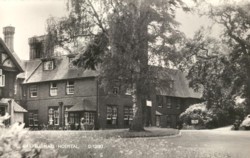
Darvell is a familiar site in the village as the home of the Darvell Bruderhof and has had an interesting history.
A former employee of Darvell Hall, Harry Bashford, has written an interesting history of the building and it is available to read here.
Early Flying - Len Woodgate
During the1930s, the field North of Langham Road,and now I believe, partly built on by the Community Colledge, had large white letters spelling out ROBERTSBRIDGE embedded therein. This was a navigational aid for the Imperial Airways Handley Page HP 42 and 45 Airliners en route to and from Croydon (the then London airport Ed.) and Paris. They were large, for those days,four engined bi-planes they looked very impressive, especially as dusk fell,as they were quite low and well lit up.
The field was occasionally used as a landing ground by the "Barnstormers" who traveled around the country offering joy-rides locally. I believe there was some friendly rivalry between some of the local young men as to who would fly first and try to impress the young ladies!!
Obviously the letters had to be removed quite quickly before the 1939/45 war commenced.
Ghosts - David Allen
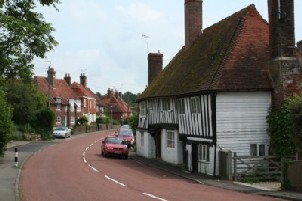
The most impressive building in Northbridge Street is Monks House, a superb timber-framed building testifying to the wealthy nature of this area in the past.
In May 1981 a fire in the roof threatened to destroy this lovely building but fortunately the prompt response of the fire services saved the main part of the building. Since the bypass had not at that time been built it can be imagined what problems this caused to what was then the main A21 road.
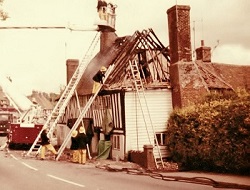
Monks HouseThe owner of the property at the time was Ted Beesley and I got to know Ted fairly well some years later when I was on the parish council as he was the Clerk to the Council. I frequently visited him at Monks House and I was curious about a short set of stairs inside that seemed to lead nowhere! The only explanation that seemed likely was that in the past, particulalry the 19th C., many properties in the village were sub-divided to accomodate more residents.
Ted told me that he and previous owners had sometimes seen a figure of a woman ascend the stairs and disappear at the top but following the fire in the roof the figure was never seen again. Now Ted was in my opinion a very down to earth person and not the sort, I thought, to believe in ghosts but there was no doubting his sincerity and I am left wondering if, as Hamlet said, "There are more things in heaven and earth than are dreamed of in our philosophy"!
Robertsbridge Home Guard 1944 - Len Woodgate
This photo was provided by Len Woodgate and he has identified as far as possible the people in it.
There are some 'blanks' and if anyone can help fill them in please get in touch.
Click the photo for a close up.
| Front row L to R | Middle row L to R | Back row L to R |
|---|---|---|
| Bill Field | Charley Palmer (D.R.) | Fred Rogers |
| Cyril Fuller | Chris Izzard | Bert Watson |
| Tinker Carley | ? | ? |
| Roland Green | ? | Bert Goodsell |
| Jimmy Pinyon | Bill Hayward | ? |
| Fred Croucher (CQMS) | Harry Stapeley | ? |
| Bill Slaughter | ? | Walter Goddard |
| Arthur Baker | ? | Len Laurence |
| Lt. Wilson Fox | Edgar Harding (MM & Bar and Croix de Guerre) | Fred Bristow |
| Dr Dingley (CO) | Jack Riddle | Walter Goodsell |
| Staff Officer | ? | Eddie Knight |
| Staff Officer | Tommy Amies | Bob Suggett |
| Len Newbury | Helen Waghorn | George Small |
| Bill Beeden | ? Miss Hurd | ? |
| Fred Fuller | Brian Barden | Bert Smith |
| Percy Turk | Doris Gillet | Sid Martin |
| Arthur Robinson | Elsie Booth | George Hardy |
| George Carter | ? Cross | ? |
| George Weston | ? | ? |
| Percy Church | ? Goldsmith | ? |
| ? | Bernard Kemp | Geoff Green |
| Ron Barden | ? Goldsmith | |
| Doug Barden | Jim Trott | |
| Jack Spilstead | Roy Steadman | |
| ? | ? | |
| Jacko Wood | John Lulham | |
| Reg Hodges | George Page | |
| ? | ||
| ? Roffey |
Doodlebugs
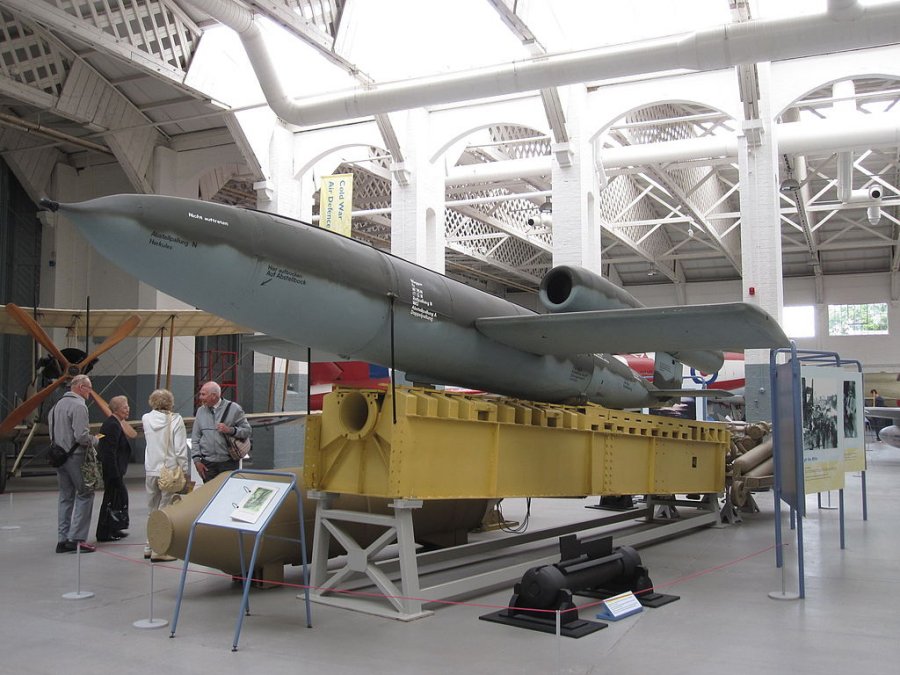

Doodlebug photo courtesy of NH53, CC BY 2.0, via Wikimedia Commons
‘Doodlebugs’ was the nickname in Britain given to the V1 rockets that the Germans launched against Britain in the later stages of World War 2, so called because of their black colour and short wings that gave them an ominous ‘beetle-like’ appearance.
They were essentially a pulse jet propelled missile which carried a large explosive charge. With short, stubby wings they flew until the fuel ran out and their droning sound caused great anxiety as people listened to see when the engine cut out. After this they might glide for a short distance but more likely just fell to earth and exploded on impact.
Here is an account of one shot down in Robertsbridge (1944?) sent in by Len Woodgate.
One evening a Doodlebug was shot down over Robertsbridge. It crashed in a field at the rear of the cricket bat factory, which was at that time situated at the rear of ‘’Coveling”, which is now the site of Oakhurst Drive. The blast blew most of the factory roofs off but strangely enough, the searchlight and machine gun post, positioned in the next field suffered no damage, and no casualties to the troops either. Rather remarkable!
The next day Mr Fred Bristow, Senior, had to collect new roofing sheets from a builder's yard in Hastings and, as a young employee, I was sent with him to help. As we only had a small truck, it took two or three trips. A Mr. Sid Martin fixed the new asbestos roofing, and he had a large screw-driver, now called a "Yankee"**, with which it seemed to be a fairly easy job.
Another memory of doodlebugs over Robertsbridge was sent to me by
Ernest Mills (known locally as ‘Nip’) As a young lad he was a witness to
one that went into a wood called Big Dead Man's wood (lies south of the
Abbey and adjoining Lordship Wood). He was pushed into a ditch by his
mum. There was a spitfire behind the doodlebug and it had tipped it into
the wood.
Spitfire pilots used to try this, for them, very risky
manoeuvre of trying to use their plane’s wings to tip the doodlebug and
make it crash before it reached its target – Ed.
Please click here for more information on doodlebugs and other rockets.
**A 'Yankee' screwdriver is a "push screwdriver", where a pushing motion is converted into a turning motion by a spiral cutting in the shaft. They can also be used as a traditional ratchet screwdriver and even as a conventional "fixed" screwdriver.
Parish News 1965
Please click here to read the 1965 Parish News.
Diary of Ethel Mercy Burchett - 1906
Please click here to read Ethel's diary.
Burchett Butcher Family Album
Ethel Burchett, the Diary writer, married Percy Butcher the son of the Robertsbridge postmaster, Their grandson Brian Thompson - see below, has found a number of interesting photos of Robertsbridge that can be seen here.
Please click here to see family album.
Holidays in Robertsbridge 1949 to 58 - Brian Thompson
Please click here to read Brian's recollections.
Down Your Way - David Allen
Down Your Way was a BBC radio series that ran from 1946 until 1992 and was usually broadcast on Sunday afternoons. It visited towns and villages around the United Kingdom, spoke to residents and played their choice of music. It was originally hosted by Stewart MacPherson until 1947 and then a succession of presenters, including Lionel Gamlin, Wynford Vaughan Thomas, Richard Dimbleby and Franklin Engelmann until 1972 when Brian Johnson, perhaps better remembered for his cricket commentaries, hosted until 1987.
In 1975, despite being the second most popular programme on radio, it was taken off air as ‘an economy measure’ but was subsequently re-instated after a storm of popular protest. From 1987 until its final demise in 1992 it was hosted by a different ‘celebrity’ every week, who would visit a place of significance in their own lives – effectively turning it into ‘Down My Way’ and blending it into the then-emerging celebrity culture. Before this however, in March 1980, the programme visited Robertsbridge and the Kent & Sussex Courier ran an article about the visit and a transcript of this can read here.
Please click here to read this transcript.
